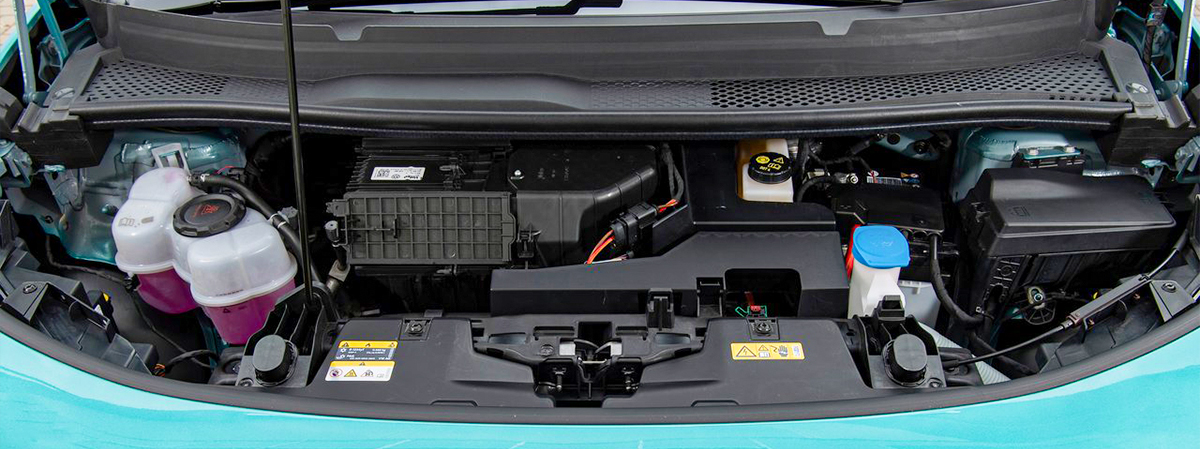EV Batteries & Motor

Looking to find out exactly how an electric vehicle works? In this guide, we'll cover the battery and the motor.
Lithium-ion
Fully electric vehicles, also known as battery electric vehicles (BEVs), are powered by large lithium-ion battery packs and not through the burning of petrol/diesel the way your standard internal combustion-engined (ICE) car does.
To simplify, an electric vehicle is a bit like a mobile phone. Mobile phones draw their power from a lithium-ion (Li-ion) battery and EVs do the same thing but with a much larger pack that's made up of thousands of individual Li-ion cells.
Lithium-ion is common in electronic devices due to its recharging capabilities. These types of batteries have a high energy density which means that lots of energy can be held within a small space - perfect for powering a car or van.
Lithium-ion is also safer than many of the alternatives out there. To ensure the safety of drivers, different safeguards have been implemented to protect batteries during repeated rapid charging sessions.
Lifecycle
When an electric vehicle is charged, electricity makes chemical changes to the Li-ion batteries which are then reversed as the car gets driven, producing electricity. This process is known as discharge.
The battery in an electric vehicle will undergo continuous cycles of charge and discharge throughout its lifespan, which, over time can cause wear. This wear decreases the vehicle’s electric range slightly, but don't worry - current estimates suggest that a battery pack could last between 10 and 20 years before needing a replacement.
Capacity and kWh
The capacity of an electric vehicle’s battery is expressed in kiloWatt hours (kWh), a measurement of energy. A 1,000 Watt drill would need 1,000 Watts (also displayed as 1kW) to make it work, meaning to power that drill for 1 hour, you would need 1 kWh of energy.
An electric vehicle's battery capacity is usually found in its derivative. For example, the Renault ZOE 100kW i GT Line R135 50kWh 5dr Auto has a 50kWh battery that has a range of about 239 miles.
Electric Motor
The electric motor is what moves an electric vehicle, with help from the battery.
The lithium-ion battery powers one or more of the electric motors, which drive the wheels and make the car move. By pressing the accelerator, an EV will instantly convert the stored DC power in the battery into AC power for the motor, which gradually consumes the energy stored in the batteries.
Unlike traditionally fueled vehicles, an electric vehicle has no alternator to recharge the battery. Instead, the motor adopts this role too, so when the accelerator pedal is lifted the rotor starts spinning faster, helping to recharge the battery.
Regenerative Braking
Regenerative braking is the term used for when electric motors send energy back into the battery that would have otherwise been lost.
When a petrol or diesel vehicle brakes, hydraulic fluid pushes the brake pads against the brake discs on the wheels. This process uses friction to convert the kinetic energy into other forms of ‘wasted’ energy that is lost to the surrounding environment. This slows the car down but isn’t particularly efficient.
On the other hand, electric vehicles are far more economical than combustion vehicles because they are able to take this energy and use it to recharge the batteries, helping prolong the vehicle’s range. Some energy will still get wasted, so it is not a perfect process, however, it certainly helps the vehicle go further on a single charge.
The electric motor in an EV moves in two directions. When moving forwards, the motor acts as normal, converting electrical energy into mechanical energy. However, when put in the opposite direction the motor works as a generator, converting mechanical energy into electrical energy.
When you lift your foot off of the accelerator the vehicle's momentum is used as the tool to turn the motor into reverse and begin storing the kinetic energy for later use. The vehicle will begin to slow down as this process takes place.
Many EVs have settings for how much regenerative braking occurs when you lift off the pedal. These settings can be adjusted on based on your personal preference; switching it to the maximum setting will typically make the vehicle operate almost solely in a single pedal capacity, ideal for easy driving in heavy traffic situations.
In the popular Nissan Leaf, single-pedal driving is called ‘e-pedal’ that can be turned on and off with the switch of a button. A brake pedal will still be present on all EVs if you’re not slowing down as quickly as desired.
For more information on electric vehicles visit our Electric Vehicle Terminology page here!

